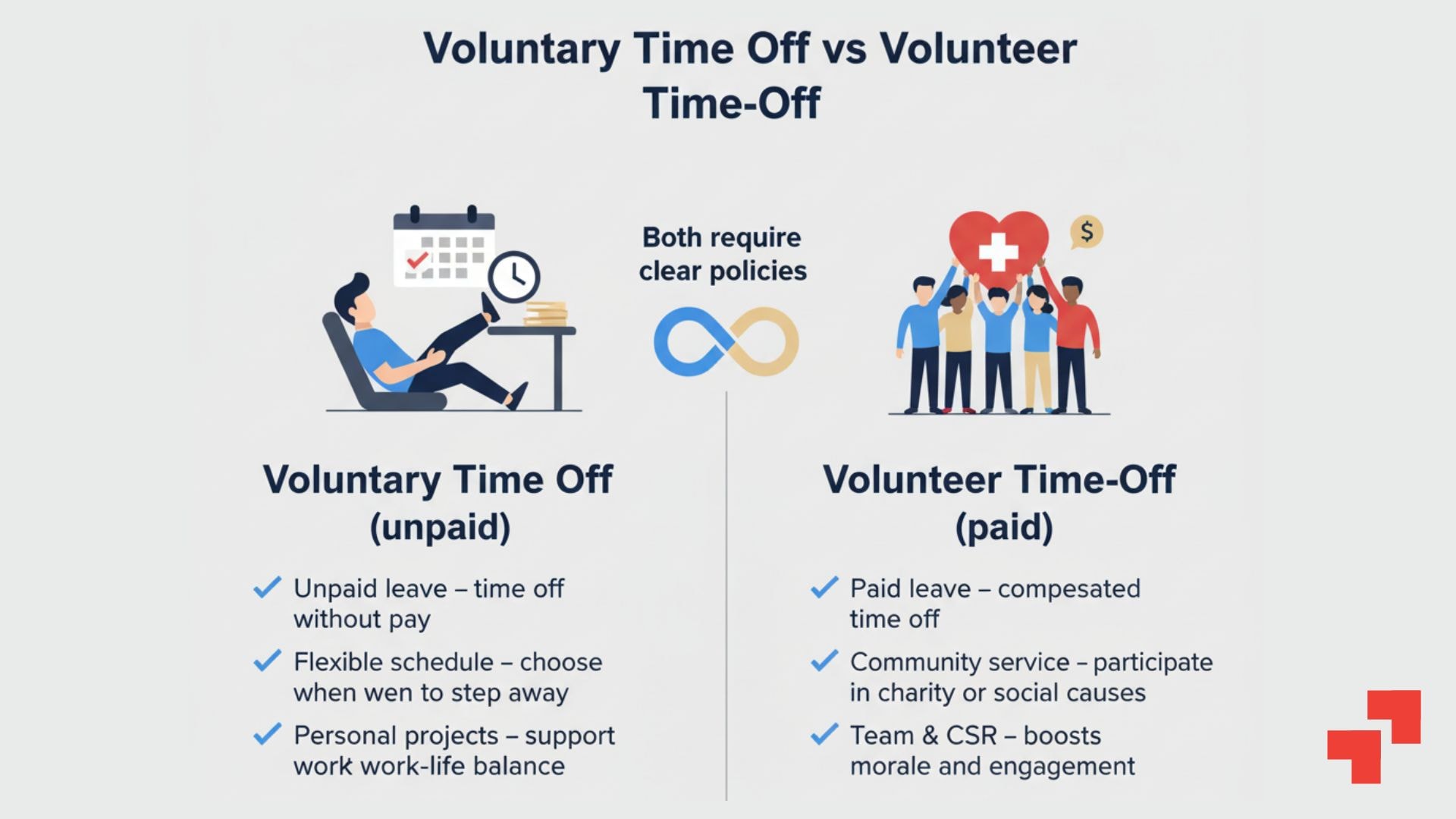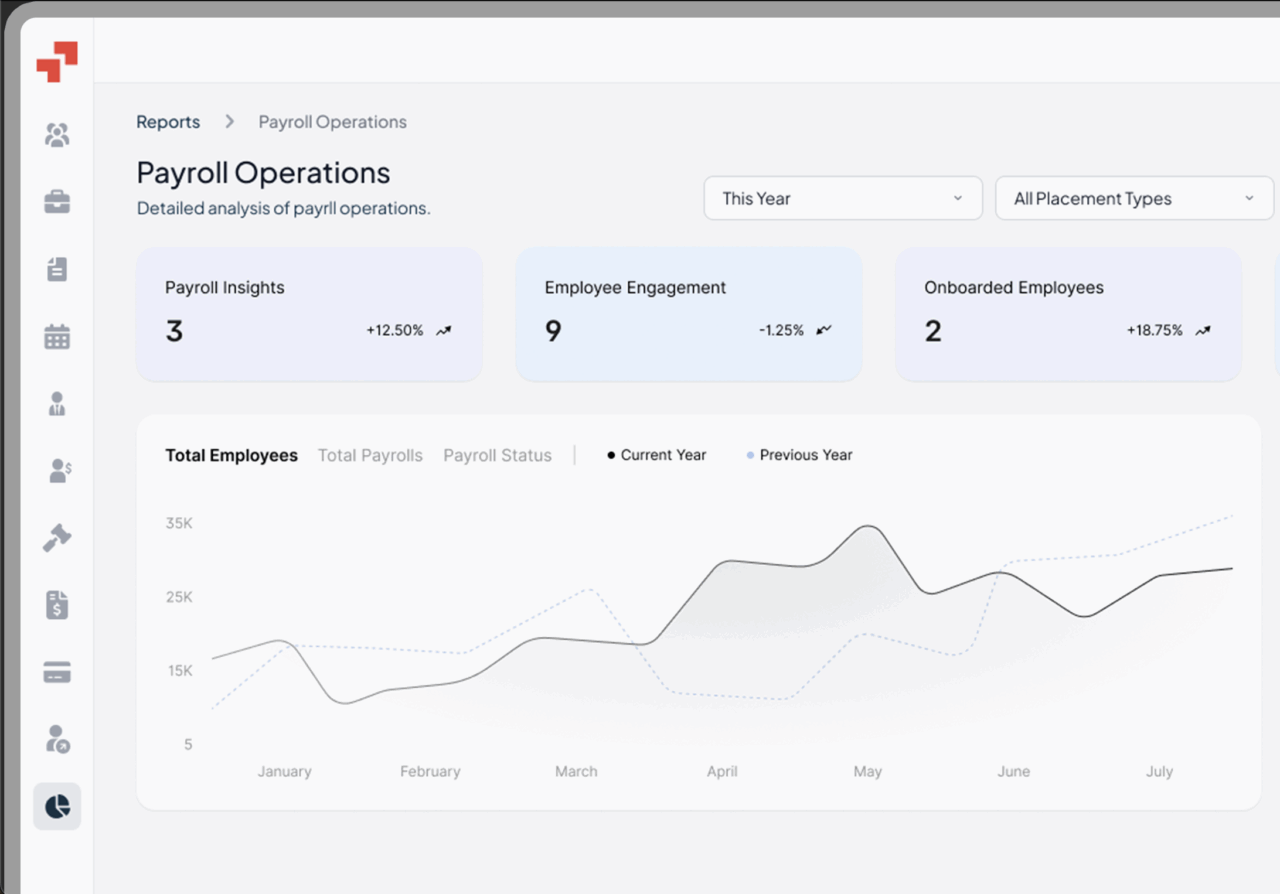Global Workforce GlossaryVoluntary Time Off
Related Terms
Floating Holiday
Tax Identification Number
W2 Employee
Holiday Pay
Form I-9
Voluntary Time Off (VTO) is an employee benefit allowing workers to take unpaid time or reduce hours voluntarily, usually during slow business periods, and to accommodate VTO requests.
Employees may take unpaid leave voluntarily as part of flexible workplace policies, giving them more control over their schedules.
In the US, Voluntary Time Off must comply with federal and state labor laws, which include the need to approve when employees request VTO. UK and EU organizations need to ensure alignment with employment/labour laws and payroll regulations to avoid penalties. VTO helps companies manage labor costs during slow periods by offering a strategic way to reduce workforce expenses without layoffs. Both types aim to improve work-life balance, employee engagement, and corporate social responsibility, and support employees in balancing their work and personal lives.
Table of Contents
- What is Voluntary Time Off
- Voluntary Time Off: Benefits and Drawbacks
- What is Volunteer Time-Off
- Volunteer Time Off: Benefits and Drawbacks
- Considerations on establishing VTO Policies
- Voluntary Time Off Policies Considerations
- Volunteer Time-Off Policies Considerations
- Voluntary Time Off (VTO) vs Paid Time Off
- What companies offer volunteer time off?
- Employee Satisfaction and Job Satisfaction
- Request Process and Approval
- Measuring Success and Impact
- Practical Example: Voluntary Time Off (Unpaid)
- Practical Example: Volunteer Time-Off (Paid)
- FAQ’s
Voluntary Time Off: Benefits and Drawbacks
Benefits of Voluntary Time Off (VTO):
- Improves employee work-life balance.
- Reduces burnout and stress during peak periods.
- Offers flexibility without impacting core operations.
- Helps manage payroll costs during slow business cycles.
- VTO typically does not impact employee benefits such as health insurance or retirement contributions; employees usually remain enrolled in their benefits programs during VTO.
- Employees should verify with HR how VTO may affect their retirement contributions.
- Working hours may affect eligibility for VTO, and total hours worked are tracked to determine qualification for voluntary time off benefits.
Drawbacks of Voluntary Time Off (VTO):
- Decreased productivity can occur if key staff take leave simultaneously, so careful management is needed to mitigate this effect.
- Unpaid nature may affect employee satisfaction for some.
- Requires clear tracking for compliance with FLSA (US) or working time regulations (UK/EU).
- Proper planning and communication are essential to ensure smooth operations and minimize disruption when multiple employees request VTO.
What is Volunteer Time-Off
Volunteer Time-Off (VTO) is paid or partially paid leave specifically granted for employees to participate in charitable activities and support community organizations, which may include both nonprofit organizations and other approved charitable entities.
Employees may use VTO to volunteer at approved charitable and nonprofit organizations, ensuring their volunteer work is recognized and compliant with company guidelines. Companies often encourage volunteering with organizations that align with the company’s mission and core values, further strengthening their commitment to social responsibility. These benefits are typically structured and communicated through a formal volunteer time off policy.
Unlike Voluntary Time Off (VTO), which is typically unpaid and discretionary, Volunteer Time-Off emphasizes CSR and engagement, thus positively impacting employee morale and resulting in potential cost savings. US companies must consider tax reporting for paid volunteer hours. UK and EU organizations must align with employment/labour laws and GDPR requirements when tracking volunteering activity.
Volunteer Time Off: Benefits and Drawbacks
Benefits of Volunteer Time-Off (VTO):
- Enhances corporate social responsibility (CSR) profile, as companies encourage employees to volunteer as part of their CSR initiatives.
- Boosts employee engagement and morale.
- Supports ESG initiatives and company reputation.
- Encourages team collaboration through volunteering activities.
- Allows employees to utilize VTO to participate in meaningful volunteer activities, often through a structured volunteer program.
- VTO is typically allocated on a calendar year basis, aligning with company planning and reporting.
Drawbacks of Volunteer Time-Off (VTO):
- Paid leave can increase short-term payroll costs.
- Scheduling challenges if many employees participate simultaneously.
- Administrative tracking is required for tax and legal compliance.
- Employees may need to submit requests to utilize VTO, so a clear process for approval and tracking is important.

Considerations on establishing VTO Policies
When establishing VTO policies (whether Voluntary Time Off or Volunteer Time-Off), organizations should define eligibility criteria, maximum hours, and a clear VTO request process for approval, involving the HR department. Employees with questions about VTO policies or eligibility should consult with an HR representative to ensure they understand the company’s rules and procedures. Offering VTO is a flexible workforce management tool that benefits the company’s employees by allowing them to balance workloads and take time off without job security concerns.
Most companies structure their VTO policies with specific allowances and restrictions, and there is a growing trend of more companies adopting VTO policies as part of their standard offerings. A clear request and approval process ensures consistency. Employers must also decide if the policy enables employees to focus on unpaid absence (Voluntary Time Off) or paid community service leave (Volunteer Time-Off) as a part of their workforce management. Aligning policies with US, UK, and EU employment laws prevents disputes and ensures compliance.
Voluntary Time Off Policies Considerations
For Voluntary Time Off (unpaid), companies should:
- Define maximum unpaid hours employees can request.
- Set a structured approval process to balance staffing needs. For example, warehouse employees may utilize VTO during slow periods to help manage overstaffing and improve operational efficiency.
- Clarify eligibility for VTO, specifying whether both full time employees and part time employees are eligible, and at what point in their employment they can participate.
- Indicate if employees are allowed to volunteer with their own charities or if they must choose from a pre-approved list of organizations.
- Clarify if VTO impacts overtime eligibility or pay cycles.
- Ensure benefits like health insurance and retirement remain unaffected.
- Align policies with FLSA (US), Working Time Regulations (UK), and EU labour law.
- Maintain transparent documentation to avoid compliance disputes.
Volunteer Time-Off Policies Considerations
For Volunteer Time-Off (paid), companies should:
- Specify the annual paid hours allocated for volunteering.
- Decide if employees can choose any charity or only company-approved causes, such as approved charitable and nonprofit organizations.
- Establish eligibility criteria (e.g., full-time vs part-time staff).
- Ensure payroll reflects paid VTO accurately.
- Confirm compliance with IRS rules (US), HMRC (UK), and GDPR (EU).
- Communicate the program clearly to encourage staff members to participate and support when employees volunteer.
- Track and document volunteer activities to ensure employees volunteer at eligible organizations and to monitor program impact.
Voluntary Time Off (VTO) vs Paid Time Off
Voluntary Time Off (VTO) is usually unpaid leave taken voluntarily by employees at their discretion, contributing to overall job satisfaction. When taking VTO, employees may experience the loss of a full day’s wages, as this time off is not compensated. However, VTO typically does not impact employee benefits such as health insurance or retirement contributions, and employees usually remain enrolled in their benefits programs during this period. It is important to verify specific benefits details with HR. Paid Time Off (PTO) combines vacation, sick leave, and personal leave into paid days off.
Volunteer Time-Off (VTO) may be paid but is restricted to charitable work, contributing positively to job security. US employers must manage accruals and tax implications. UK/EU organizations need to ensure VTO or Volunteer Time-Off does not replace legally mandated leave.
Understanding the difference helps companies structure benefits while remaining compliant and employee-friendly.
What companies offer volunteer time off?
Many tech, SaaS, and professional services companies implement a volunteer time off policy to provide Volunteer Time-Off (VTO) as a benefit for the company’s employees.
Recently, more companies are adopting VTO programs as part of their standard offerings, recognizing the positive impact on both the business and its employees. Most companies typically allow a set number of paid hours or days for employees to participate in volunteer activities, with some variations in policy details.
Example 1:
US Examples: Salesforce, HubSpot, and smaller startups focused on CSR.
Example 2:
UK Examples: Deloitte, PwC, and mid-sized SaaS firms.
Example 3:
EU Examples: German, French, and Dutch companies integrate Volunteer Time-Off into ESG and employee engagement programs.
Offering Volunteer Time-Off (VTO) enhances retention, morale, and social impact in local communities, thus attracting socially responsible talent and enhancing employer branding while creating a culture of corporate responsibility and employee satisfaction.
Employee Satisfaction and Job Satisfaction
A well-designed VTO policy can have a significant positive impact on employee satisfaction and job satisfaction. By offering voluntary time off, companies show a genuine commitment to employee welfare and work-life balance, which helps boost employee morale and overall job satisfaction. When employees have the flexibility to pursue personal interests or participate in volunteer activities, they feel more valued and supported in their personal and professional lives. This sense of fulfillment often translates into higher engagement and loyalty to the company.
Moreover, VTO policies that emphasize social responsibility can attract and retain socially responsible talent, individuals who prioritize working for organizations that align with their values. Employees are increasingly seeking workplaces that support their desire to make a difference, and a strong VTO policy signals that a company cares about both its people and the broader community. Ultimately, prioritizing employee satisfaction through voluntary time off not only enhances job satisfaction but also strengthens the company’s reputation as a socially responsible and employee-focused employer.
Request Process and Approval
A transparent and efficient request process is essential for the success of any VTO policy. Companies should establish clear guidelines for how employees can submit VTO requests, including the necessary forms, timelines, and any documentation required. The approval process should be straightforward, with managers or HR representatives reviewing requests based on business needs, staffing levels, and the potential impact on team operations.
To approve VTO requests fairly, it’s important that the process is consistent and free from bias. Clear communication about the status of each request, whether approved or denied, helps build trust and encourages participation in VTO programs. Leveraging HR software or digital platforms can further streamline the request process, making it easier for employees to request VTO and for managers to track and manage approvals. By providing clear guidelines and a user-friendly request process, companies can reduce administrative burdens and foster a positive environment where employees feel empowered to utilize voluntary time off.
Measuring Success and Impact
To ensure that a VTO policy delivers meaningful results, companies should establish clear metrics for measuring its success and impact. Key indicators might include employee engagement levels, participation rates in the VTO program, and employee satisfaction scores. Tracking the number of VTO hours used, the variety of volunteer activities undertaken, and the tangible benefits to community organizations can also provide valuable insights.
Measuring the impact of VTO policies not only demonstrates a company’s commitment to social responsibility and employee welfare but also supports employer branding efforts. Data-driven evaluation allows organizations to showcase the positive effects of their VTO program, such as improved morale, higher retention rates, and stronger community relationships, to both current and prospective employees. By regularly reviewing these metrics, companies can identify areas for improvement, make strategic adjustments, and ensure that their VTO policy continues to align with business objectives and the needs of their workforce.
Practical Example1: Voluntary Time Off (Unpaid)
US SaaS Startup
A SaaS company in San Francisco faced seasonal dips in project demand. Instead of layoffs, they introduced a Voluntary Time Off (unpaid) policy, structured around the calendar year. Employees, including warehouse employees in their logistics division, could submit requests for unpaid leave without losing their health benefits or employment status.
Within the first quarter, 15 employees opted in, saving the company $25,000 in payroll and helping both the company and employees with saving money during slow periods. Staff valued the flexibility, and no compliance issues arose as the policy followed FLSA guidelines.
The initiative built goodwill, reduced burnout, and helped the startup stabilize costs while preparing for its next funding round.
Practical Example 2: Volunteer Time-Off (Paid)
UK FinTech Company
A London-based FinTech firm rolled out a Volunteer Time-Off (paid) program as part of its structured volunteer program, offering employees 20 hours annually for charity work, allocated per calendar year. Staff could support any registered UK charity, but the company encouraged projects aligned with financial literacy.
Employees utilize VTO to engage in community service, joining HMRC-approved community education drives and teaching budgeting skills in schools. Payroll reflected these hours as paid, ensuring transparency and compliance.
Employee engagement rose sharply: 82% participation, with retention improving by 15%. The firm gained positive press coverage, boosting its brand reputation among clients and potential hires.
FAQ’s
Is Voluntary Time Off same as Volunteer Time-Off?
No. Voluntary Time Off (VTO) is unpaid leave taken at the employee’s discretion. Volunteer Time-Off (VTO) is paid or partially paid for charitable or community service. Both fall under the VTO umbrella but serve different purposes.
Can I refuse VTO when offered?
Yes. Participation in both Voluntary Time Off (VTO) and Volunteer Time-Off (VTO) is optional. Employees can decline without penalty.
Can VTO be reversed?
Voluntary Time Off (VTO) may be canceled if business needs require it, but policies should outline notice and approval rules. Volunteer Time-Off (VTO) is rarely reversed once approved unless critical operational issues arise.
Can VTO be denied?
Yes. Employers can deny requests for both Voluntary Time Off (VTO) and Volunteer Time-Off (VTO) to ensure operational coverage, provided the policy is applied consistently and in compliance with US, UK, and EU labor/employment laws.
Hire the Best Talent, Anywhere






